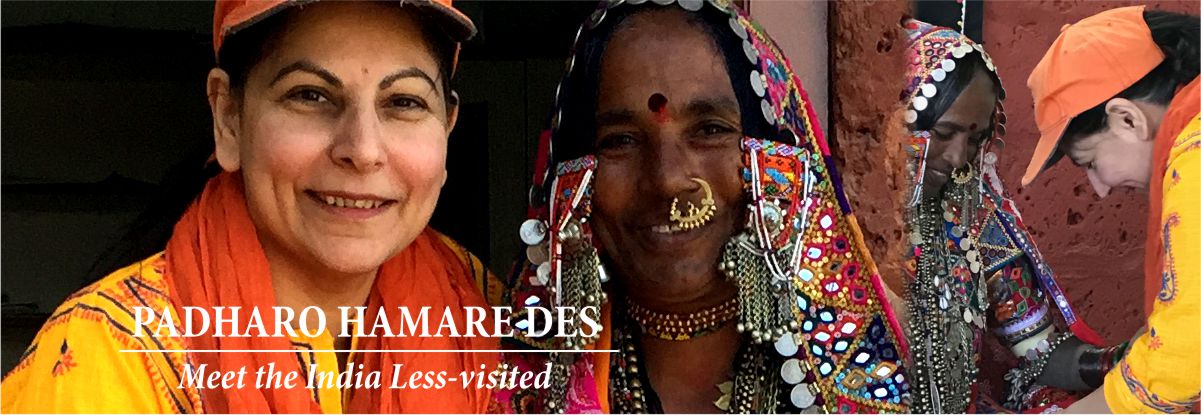Nomadic. Rooted.

The image above captures the glorious freedom of spirit and strong sense of identity that is associated with the nomadic “Banjaras”. The nomadic tribes originate from the desert sands of Rajasthan and Gujarat from where a group journeyed through to the Northern part of Karnataka in Southern India. The tribe is known as the Lambanis.
The heavy, layered style of jewellery, the chunky pieces complimented with delicate dangling chains and bells, the borders framing theirs attire meticulously embroidered in square and round mirror-work, the colourful continuum of patchwork, into which are sewn in conch-shells and finally the stunning array of silver coins accenting the edges…these are merely the few ornaments adorning the braided hair and covered head!
There are delicate nose-pins or nose-rings, chokers in beads or silver, longer neck-pieces with pendants, bracelets commencing on the wrists that then are layered right up to the armpits, amulets, anklets and the usual rings et al.
The skirts are always in brilliant colours, flowing, layered and swirling around the ankles in consonance with the majestic gait that is the hallmark of these striking handsome women. The cholis or blouses are each, individual, works of art. The centre piece for the yolk is traditionally rectangular with larger and small mirror and patterns created in patchwork and the sleeves are perfectly symmetrical and compliment the structure and form of the yolk. The back is open and pulled close using tie-back with tassels at the ends. This allows for the blouse to fit over the course of a woman’s lifetime! Its comfortable, convenient and gorgeous. They don’t dress, to follow or create fashions. They dress to express and be who they are. Banjaras.
There is often supreme irony in the role perception plays in social commentary. The nomadic tribes are the timeless travellers and journeymen. In my view, they anticipated and as part of their view of a natural order, lived the life globalization has over the last decades triggered in countries across the world. We’ve witnessed unprecedented migrations of people from rural to urban, as globalization, powered by the internet and open markets, created opportunities for skills-development and employment.
The Banjaras, have for centuries, travelled from one place to another, displaying their unique crafts, their products with an innate entrepreneurial streak and a natural ease of doing business. Their women have sung the songs of creation and sewn together patches of clashing colours, different textures and then embroidered patterns that reveal the glory of Nature. Their mystical tattoos symbolize their unique interpretation of an eternal order. These are never random or devoid of meaning. On the contrary, each is always perfectly uniform in content and form and consistent, in keeping with the origins of the tribe and the individuals place in the universe which is never constant but always dynamic and evolving. To one tattoo is added another as the person experiences the next milestone. Every piece of ornament, every piece of garment and every tattoo is in harmony with the individuals roots and place in the world.
If we took a hard and honest look at the nomadic tribes, we would discover that they were indeed the first expressions of what was to follow as an emerging global world-view. They did not choose to champion this change nor is there any evidence of their attempting to influence existing social orders, as they walked besides the established status quo, at their own pace, following their own rituals and traditions, inhabiting an alternate and parallel way of life. In truth, the were never considered for any permanent membership in any social context nor expected to participate integrally in any fashion. Their lot and their choice remained, in perpetuity, at the periphery.
The Banjaras have remained rooted in the most holistic meaning of the word even as they travelled from place to place. We, the other part of humanity, that formulated written and spoken language and attributed meaning to words that came from our singular reference-points, have referred to their state of being, as nomadic or “rootless”. As though being rooted was a physical state of being!
As migrations increase and cities expand into bordering villages and the lines become more blurred, there are growing concerns of traditions being eroded, cultures being diluted, indigenous populations being overwhelmed by the influx of “outsiders” or migrants and the migrants themselves, dealing with the angst of “loss of identity”.
A few moments of gazing into this photograph would help draw attention to the reality that in a transient, impermanent lifetime, the Banjaras and Nomads, exemplify what being “rooted” should be. To be free to roam freely, to journey through life working to earn an honest living, to engage with all peoples equally, to belong everywhere and no where, to carry one’s roots and identity within oneself and wear it on one’s person with abandon, these are life’s best lessons and there are no schools and universities where these can be learnt.
The Nomads are perhaps the finest icons of lives well-lived. Free yet rooted.
Categories

